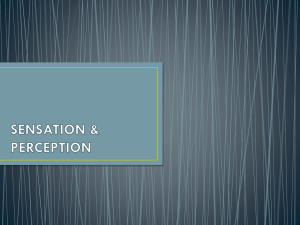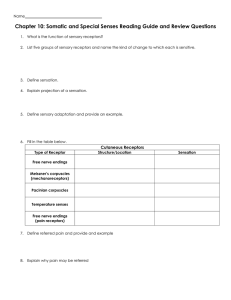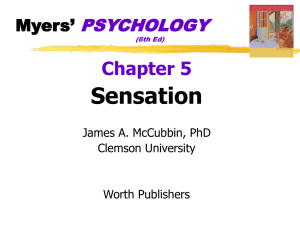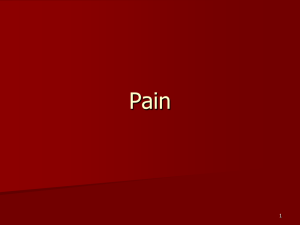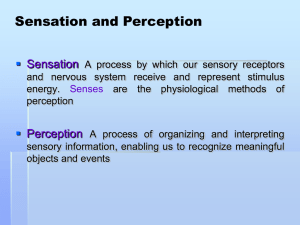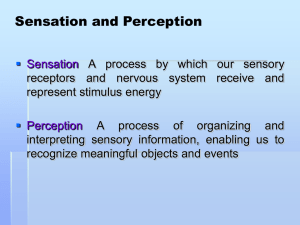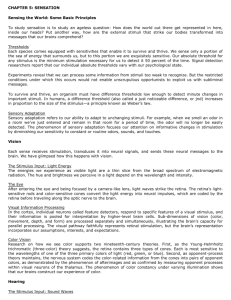Sensation
advertisement
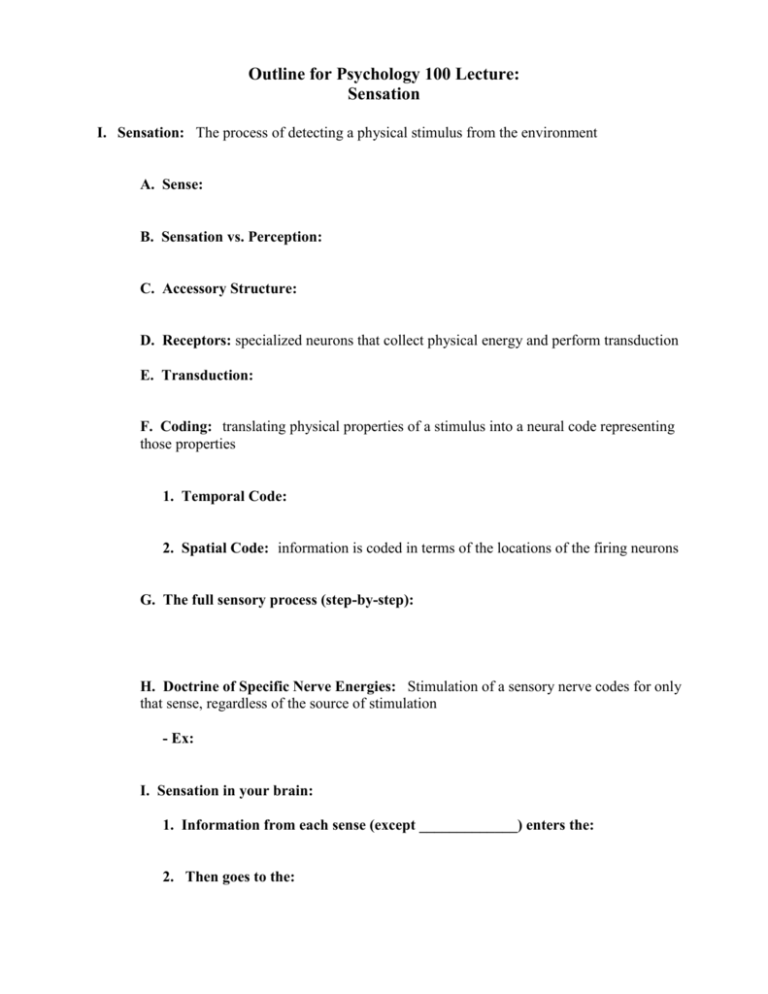
Outline for Psychology 100 Lecture: Sensation I. Sensation: The process of detecting a physical stimulus from the environment A. Sense: B. Sensation vs. Perception: C. Accessory Structure: D. Receptors: specialized neurons that collect physical energy and perform transduction E. Transduction: F. Coding: translating physical properties of a stimulus into a neural code representing those properties 1. Temporal Code: 2. Spatial Code: information is coded in terms of the locations of the firing neurons G. The full sensory process (step-by-step): H. Doctrine of Specific Nerve Energies: Stimulation of a sensory nerve codes for only that sense, regardless of the source of stimulation - Ex: I. Sensation in your brain: 1. Information from each sense (except _____________) enters the: 2. Then goes to the: 3. 4. Density of nerves in a sense organ = 5. 6. After primary sensory cortex, areas of association cortex combine sensory info from >1 sense. II. Hearing A. Sound: a repetitive fluctuation in the pressure of a medium, such as air. 1. Physical characteristics of sound: a. Amplitude: difference between the peak and the baseline of a waveform. - It is basically the INTENSITY of the sound. b. Wavelength: c. Frequency: number of complete waveforms, or cycles, that pass a given point each second 2. Psychological dimensions of sound: a. Loudness: b. Pitch: How high/low a tone sounds. - Depends on the frequency of sound waves. c. Timbre: 3. The Ear and hearing: a. Pinna: the visible outer part of our ear b. Tympanic Membrane (eardrum) in the middle ear: 2 c. Malleus (hammer), Incus (anvil) and Stapes (stirrup): amplify the pressure changes that the original sound waves made in the air and focus them onto the oval window d. Cochlea: i. Basilar Membrane: ii. Organ of Corti: contains hair cells that connect with the auditory nerve that goes to the brain, sending it a message about the amplitude (loudness) and frequency (pitch) of the sound. e. Auditory Nerve: f. In the brain: i. Auditory nerve takes sound info: ii. From Thalamus, relayed to Primary Auditory Cortex: - Location of sound determined by: 4. Deafness: a. Conduction Deafness: when the 3 middle ear bones fuse together b. Nerve Deafness: III. Vision A. Physical Stimulus for vision: Light Waves 1. Visible light: 2. Light intensity: how much energy the light contains 3. Color we see depends on: 3 B. Parts of the Eye: 1. Cornea: 2. Lens: a. Accommodation: ability of the lens to change shape to more clearly focus images on the retina 3. Pupil: a. Iris: the colored part of the eye; a ring of muscles that control the dilation of the pupil 4. Retina: 5. Fovea: central area of the retina C. How the parts of the eye work: 1. Light enters the eye through the cornea 2. 3. 4. Next goes to the lens: 5. D. Inside the Retina: 1. Photoreceptors: a. Contain Photopigments: chemicals that respond to light. b. Dark Adaptation: c. 2 types of Photoreceptors: i. Rods: 4 ii. Cones: d. Details about Fovea: i. ii. High concentration of cones, no rods iii. IV. Interaction of Senses: A. Synesthesia: An unusual interaction of the senses a.) Examples: b.) Neural basis: V. The Chemical Senses: Smell & Taste: A. Olfaction (Smell): detects chemicals that are airborne (“volatile”) a.) Receptors: b.) Olfactory bulb: c.) Olfaction & Emotional Memory: d.) Sensitivity to smell: i. Pheromones: chemicals released by 1 animal & detected by another; shape the 2nd animal’s behavior or physiology 5 2. Gustation (Taste): detects chemicals in solution that come in contact with receptors in the mouth a.) Receptors: b.) four main tastes: sweet, sour, bitter, salty c.) “Supertasters”: 3. Smell, Taste & Flavor a.) Anosmia: b.) Flavor: smell & taste acting together as one system - Capsaicin: VI. Somatic Senses: A. Touch: a.) energy: b.) Free Nerve Endings: receptors involved in the sense of touch c.) Adaptation: d.) We gather information about: i. intensity: how heavy a stimulus is (firing rate, # of neurons stimulated) ii. location: 2. Temperature: a.) 2 receptor types: i. warm fibers: increase their firing rates when the temperature changes in the range of about 95-115 degrees F 6 ii. cold fibers: 3. Pain: a.) 2 types of pain fibers: i.) A-delta fibers: carry sharp, pricking pain; they are myelinated to carry inputs quickly ii.) C fibers: b.) Emotional Aspects of pain: c.) Gate-Control Theory: Sensation of pain is controlled by “gates” that open & close in the spinal cord i.) Analgesia: - Natural Analgesics: - Serotonin: can block pain pathways to brain - Endorphins (natural opiates): 7
